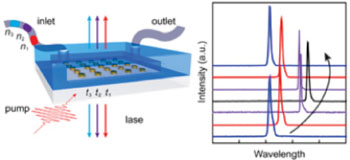Liquid Nanolaser Technology May Be Used for Lab-on-a-Chip Diagnostic Applications
By LabMedica International staff writers
Posted on 08 Jul 2015
Improvements in nanoscale laser technology enable biotechnology researchers to envisage the use of such a device as the focal point for "lab on a chip" diagnostic applications.Posted on 08 Jul 2015
Investigators at Northwestern University (Evanston, IL, USA) described an approach to achieve real-time, tunable lattice plasmon laser capability in the April 20, 2015, online edition of the journal Nature Communications. Their tunable liquid-based laser was constructed from arrays of gold nanoparticles and liquid gain materials.

Image: Tunable lattice plasmon lasers offer prospects to enhance and detect weak physical and chemical processes on the nanoscale in real time (Photo courtesy of Northwestern University).
Optically pumped arrays of gold nanoparticles surrounded by liquid dye molecules exhibited lasing emission that could be tuned as a function of the dielectric environment. Wavelength-dependent time-resolved experiments showed distinct lifetime characteristics below and above the lasing threshold. By integrating gold nanoparticle arrays within microfluidic channels and flowing in liquid gain materials with different refractive indices, the investigators achieved dynamic tuning of the plasmon lasing wavelength.
Nanoscale lasers can be mass-produced with emission wavelengths over the entire gain bandwidth of the dye employed. Thus, the same gold nanoparticle array can exhibit lasing wavelengths that can be tuned over 50 nanometers, from 860 to 910 nanometers, simply by changing the solvent used to dissolve the dye.
“Our study allows us to think about new laser designs and what could be possible if they could actually be made,” said Dr. Teri W. Odom, professor of chemistry at Northwestern University. “My lab likes to go after new materials, new structures, and new ways of putting them together to achieve things not yet imagined. We believe this work represents a conceptual and practical engineering advance for on-demand, reversible control of light from nanoscopic sources.”
Related Links:
Northwestern University














